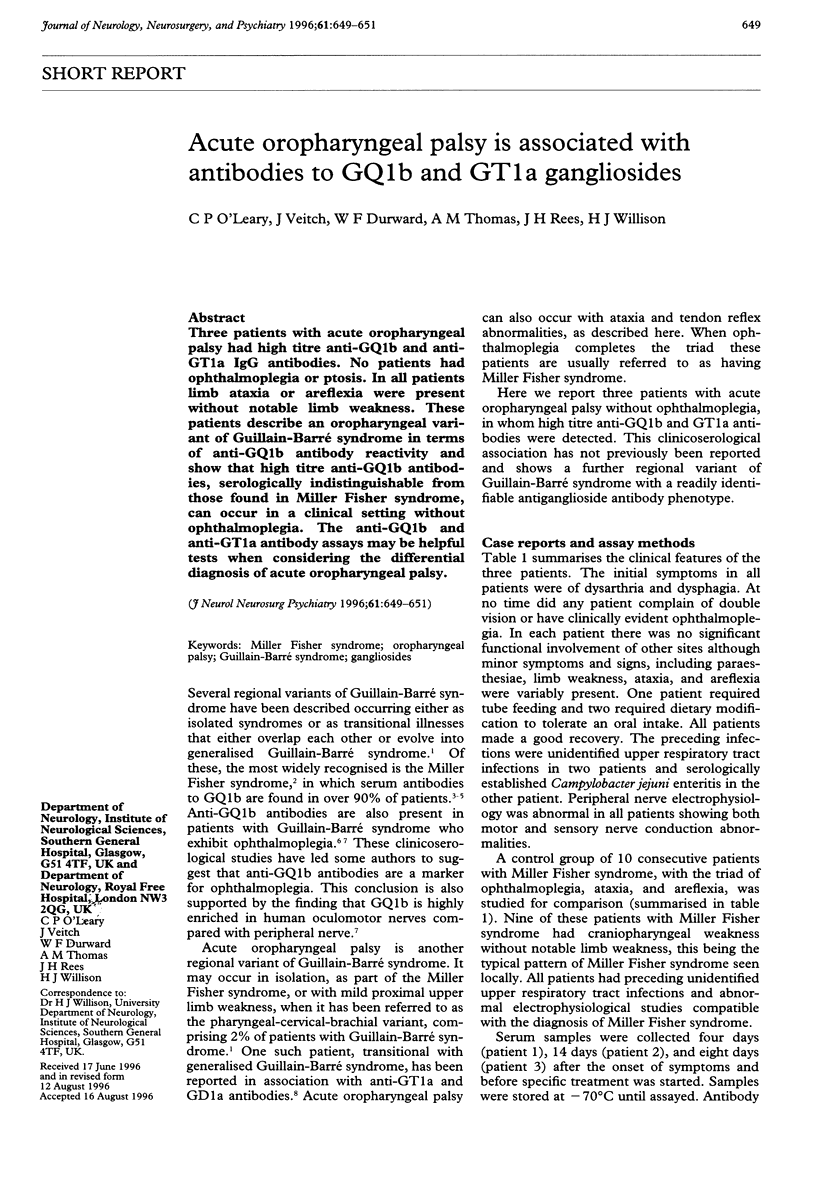Abstract
Three patients with acute oropharyngeal palsy had high titre anti-GQ1b and anti-GT1a IgG antibodies. No patients had ophthalmoplegia or ptosis. In all patients limb ataxia or areflexia were present without notable limb weakness. These patients describe an oropharyngeal variant of Guillain-Barré syndrome in terms of anti-GQ1b antibody reactivity and show that high titre anti-GQ1b antibodies, serologically indistinguishable from those found in Miller Fisher syndrome, can occur in a clinical setting without ophthalmoplegia. The anti-GQ1b and anti-GT1a antibody assays may be helpful tests when considering the differential diagnosis of acute oropharyngeal palsy.
Full text
PDF


Selected References
These references are in PubMed. This may not be the complete list of references from this article.
- Chiba A., Kusunoki S., Obata H., Machinami R., Kanazawa I. Serum anti-GQ1b IgG antibody is associated with ophthalmoplegia in Miller Fisher syndrome and Guillain-Barré syndrome: clinical and immunohistochemical studies. Neurology. 1993 Oct;43(10):1911–1917. doi: 10.1212/wnl.43.10.1911. [DOI] [PubMed] [Google Scholar]
- Chiba A., Kusunoki S., Shimizu T., Kanazawa I. Serum IgG antibody to ganglioside GQ1b is a possible marker of Miller Fisher syndrome. Ann Neurol. 1992 Jun;31(6):677–679. doi: 10.1002/ana.410310619. [DOI] [PubMed] [Google Scholar]
- Dehaene I., Martin J. J., Geens K., Cras P. Guillain-Barré syndrome with ophthalmoplegia: clinicopathologic study of the central and peripheral nervous systems, including the oculomotor nerves. Neurology. 1986 Jun;36(6):851–854. doi: 10.1212/wnl.36.6.851. [DOI] [PubMed] [Google Scholar]
- FISHER M. An unusual variant of acute idiopathic polyneuritis (syndrome of ophthalmoplegia, ataxia and areflexia). N Engl J Med. 1956 Jul 12;255(2):57–65. doi: 10.1056/NEJM195607122550201. [DOI] [PubMed] [Google Scholar]
- Mizoguchi K., Hase A., Obi T., Matsuoka H., Takatsu M., Nishimura Y., Irie F., Seyama Y., Hirabayashi Y. Two species of antiganglioside antibodies in a patient with a pharyngeal-cervical-brachial variant of Guillain-Barré syndrome. J Neurol Neurosurg Psychiatry. 1994 Sep;57(9):1121–1123. doi: 10.1136/jnnp.57.9.1121. [DOI] [PMC free article] [PubMed] [Google Scholar]
- Ropper A. H. Miller Fisher syndrome and other acute variants of Guillain-Barré syndrome. Baillieres Clin Neurol. 1994 Apr;3(1):95–106. [PubMed] [Google Scholar]
- Willison H. J., Almemar A., Veitch J., Thrush D. Acute ataxic neuropathy with cross-reactive antibodies to GD1b and GD3 gangliosides. Neurology. 1994 Dec;44(12):2395–2397. doi: 10.1212/wnl.44.12.2395. [DOI] [PubMed] [Google Scholar]
- Willison H. J., Veitch J. Immunoglobulin subclass distribution and binding characteristics of anti-GQ1b antibodies in Miller Fisher syndrome. J Neuroimmunol. 1994 Mar;50(2):159–165. doi: 10.1016/0165-5728(94)90042-6. [DOI] [PubMed] [Google Scholar]
- Willison H. J., Veitch J., Paterson G., Kennedy P. G. Miller Fisher syndrome is associated with serum antibodies to GQ1b ganglioside. J Neurol Neurosurg Psychiatry. 1993 Feb;56(2):204–206. doi: 10.1136/jnnp.56.2.204. [DOI] [PMC free article] [PubMed] [Google Scholar]
- Yuki N., Sato S., Tsuji S., Ohsawa T., Miyatake T. Frequent presence of anti-GQ1b antibody in Fisher's syndrome. Neurology. 1993 Feb;43(2):414–417. doi: 10.1212/wnl.43.2.414. [DOI] [PubMed] [Google Scholar]


